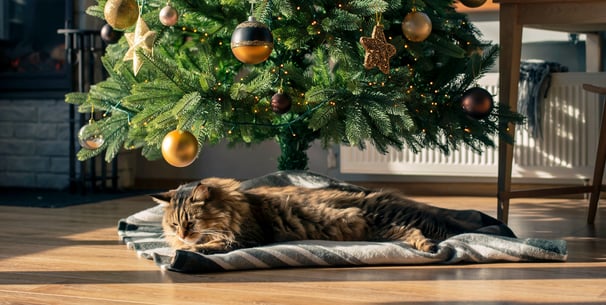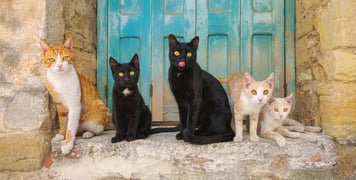Index:
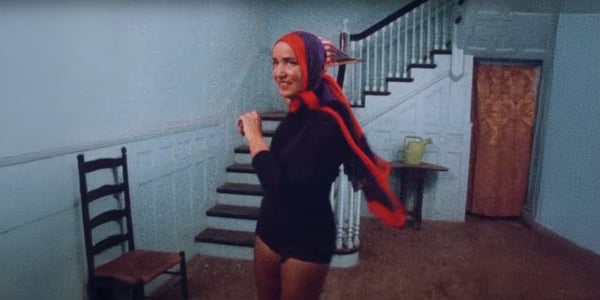


“Oozing with romance, ghosts, and other things”
When Big Edie Beale wistfully describes her crumbling East Hampton mansion as “oozing with romance, ghosts, and other things,” she could just as easily be speaking about her own life, or the life she shares with her daughter, Little Edie. Albert and David Maysles’ 1975 documentary ‘Grey Gardens’ immortalised these two reclusive women - once glittering socialites and relatives of Jackie Kennedy Onassis, now fading into eccentricity - as they lived amid the ruin of their decaying family home.
But the Beales are not alone in their peculiar kingdom. Slipping in and out of every room, perched on furniture, and padding across torn wallpaper, newspapers and fragments from a life once lived are dozens of cats, as integral to the fabric of Grey Gardens as its peeling paint, broken staircases and hoards of dusty furniture.
The cats of Grey Gardens are not mere background detail. They carry symbolic weight, shaping how viewers understand femininity, eccentricity, and resistance to societal norms. To watch ‘Grey Gardens’ is to witness not only a portrait of two extraordinary women with cult status but also the quiet, persistent presence of cats; creatures that embody independence, chaos, comfort, and survival.
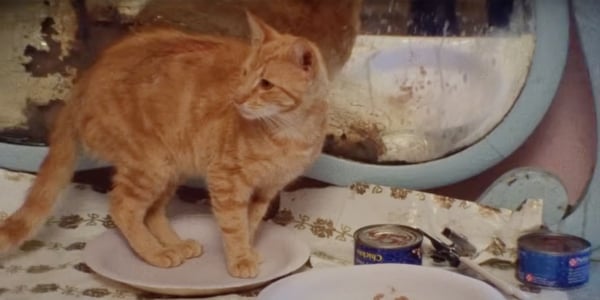


Cats as companions in a feminine space
From the opening moments of the documentary, the cats of Grey Gardens establish themselves as part of the Beales’ household dynamic. They lounge on beds, peek out from behind furniture, and, most notoriously, relieve themselves in corners of the mansion. Their abundance conjures the figure of the “cat lady” - a cultural archetype coded as feminine, eccentric, and marginalised.
In the documentary, however, this stereotype is not simply played for ridicule. Instead, the cats reinforce the Beales’ own self-fashioning as women who reject ordinary domestic expectations. Cats are traditionally associated with femininity: elusive, sensual, and independent, they have long been symbols of female mystery. The Beales’ relationship with their cats taps into this symbolism, highlighting a version of femininity that is both intimate and unruly.
Little Edie, with her inventive headscarves, skirts, and theatrical monologues, embodies this unruly femininity most vividly. She fusses over the cats, chastises them, and, at times, seems to treat them as an audience for her performances. The cats thus become companions in solitude; fellow outsiders in a household that exists outside conventional social structures.
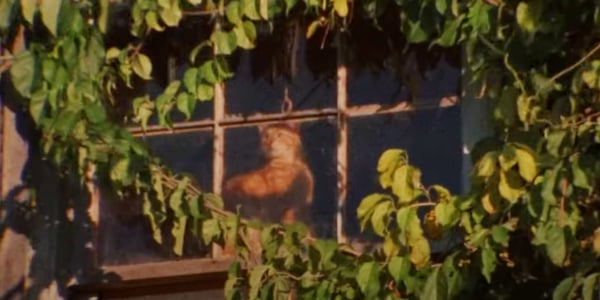


Femininity and domestic decay
The presence of so many cats within this once-grand mansion inevitably invites questions about domesticity. Traditionally, femininity has been tied to homemaking, order, and hospitality; however, the Beales subvert this ideal entirely. Their home, filled with clutter, raccoons, and cat waste, becomes a space of resistance rather than refinement.
Instead of the pristine domestic order expected of women of their class and era, Grey Gardens presents an alternative vision of womanhood - one that embraces decay, memory, and improvisation. Cats thrive in this environment: they are creatures that slip through cracks, adapt to mess, and claim spaces as their own. Their survival mirrors that of the Beales. Just as the Beales cling to their independence despite dwindling resources, so too do the cats find ways to thrive in the ruins.
In this way, the cats highlight the Beales’ rejection of patriarchal domesticity. The traditional feminine role might demand keeping a house spotless for a husband or children, but the Beales’ house is for themselves and their animals. Their mess, like their eccentricity, becomes a form of self-definition, and arguably self-sabotage.
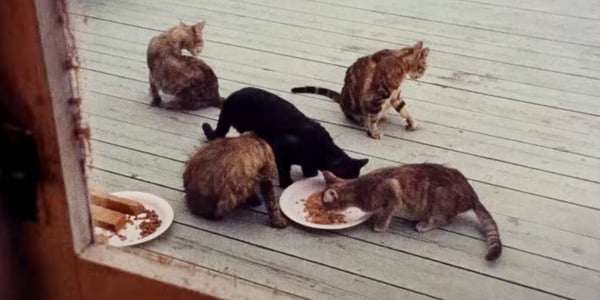


The Gothic feminine: Romance and ghostliness
From the opening scenes of the film, we can see that the house is a Gothic space, haunted by the memory of parties, male suitors, and the Beales’ former grandeur. Cats, often associated with witchcraft and superstition, deepen this Gothic atmosphere. They appear like spectres, gliding through rooms, their eyes glowing in dim light.
In Gothic literature, women are often trapped in decaying mansions, their lives marked by longing, memory, and loss. Big and Little Edie fit this archetype perfectly, and their cats amplify it. As ghostly witnesses, the cats accentuate the Beales’ status as living relics of another era.
Yet there is also romance in this Gothic imagery. The cats’ presence, though chaotic, softens the decay. They provide the Beales with comfort, companionship, and vitality. The house may be haunted, but it is not empty. It teems with life, even if that life takes the form of purring bodies weaving between broken furniture.
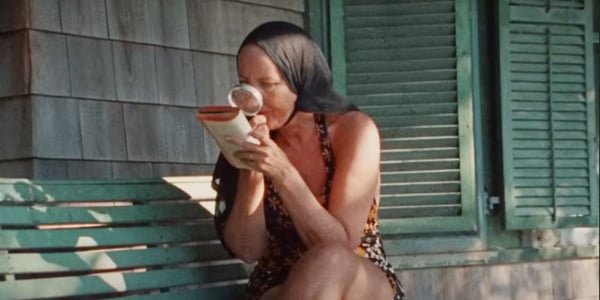


Cat ownership as agency and resistance
To surround oneself with cats is, in some cultural readings, to declare independence from traditional family structures. The figure of the “cat lady” may be mocked, but she is also free: free from marital obligations, free from expectations of cleanliness, free to live according to her own desires.
For the Beales, who were abandoned financially and emotionally by the men of their family, cats became a substitute community. But more than that, they became a symbol of defiance. Where a patriarchal order might expect widows or spinsters to disappear quietly into obscurity, the Beales did the opposite: they made themselves the centre of their own eccentric universe, surrounded by creatures that reflected their refusal to conform.
Cats, with their notorious independence, embody this refusal to conform. They do not obey in the way dogs do; they live alongside humans rather than for them. By choosing cats as their companions, the Beales implicitly align themselves with a vision of femininity that is self-determined, chaotic, and proud.
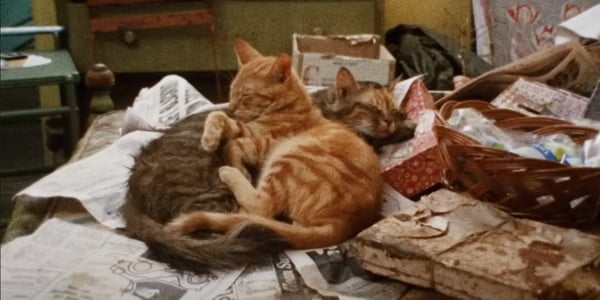


Conclusion
The cats of Grey Gardens are more than pets or symbols. They are part of the texture of the Beales’ lives, embodying themes of companionship, resistance, decay, and ghostliness. They make the Beales’ eccentric femininity visible, reminding viewers that womanhood need not conform to domestic ideals of cleanliness, order, or marital stability.
“Oozing with romance, ghosts, and other things”: the Beales’ phrase applies equally to their cats. The romance lies in the affection they share, the ghosts in their haunting presence in a decayed house, and the “other things” in the messy, uncontainable life that continues to thrive despite everything. To watch Grey Gardens, especially in 2025, is to glimpse a different kind of femininity - one that, like the cats themselves, is unruly, independent, and defiantly alive. It may also give you the opportunity to reflect on the bond you share with your own pet. Perfect? No, but a committed understanding and unspoken language that transcends and defies stereotypes and expectations.
‘Grey Gardens’ is currently available to stream through Apple TV.
Waggel Pet Insurance
Need more help? You're in luck if you're a Waggel Pet Insurance member. Along with our excellent coverage, we offer access to a 24/7 online vet to answer all your sticky questions, especially if you need grooming assistance.
Not a member? Why not get a quote now and cover your furry friend for a range of illnesses, all while enjoying our amazing perks and rewards.
Want more like this?
Get updates from us with helpful info, advice, answers to frequently asked questions and much more.
Index:
Related posts:
Get your quote
Along with our excellent coverage, we offer access to a 24/7 online vet to answer all your sticky questions.
